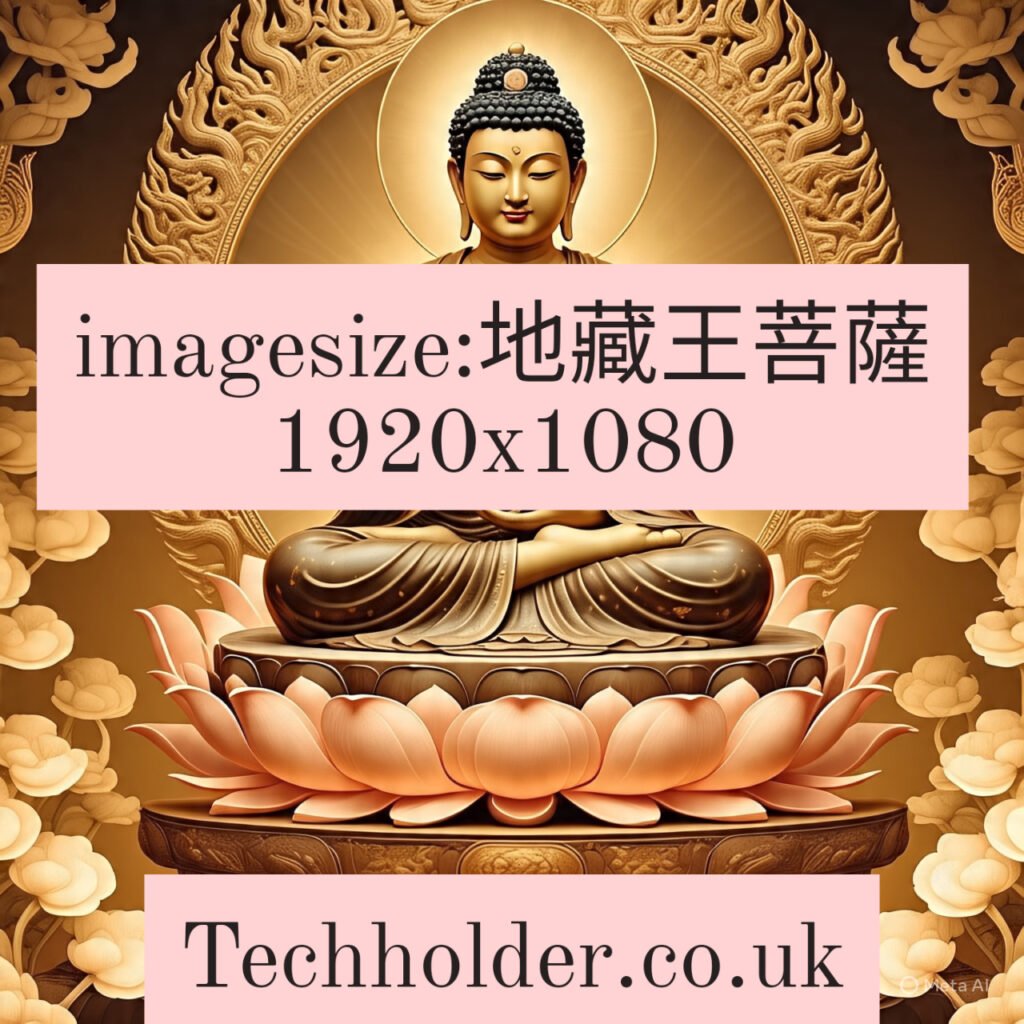
Introduction:
Among the most revered figures in East Asian Buddhism, Kṣitigarbha Bodhisattva, known in Chinese as 地藏王菩薩 (Dìzàng Wáng Púsà), holds a sacred place in the hearts of millions. This celestial being is venerated for his deep compassion, vow to save beings from suffering, and unwavering commitment to guiding souls from the realms of hell. With the rise of digital devotion and the fusion of art with modern technology, the keyword imagesize:地藏王菩薩 1920×1080 has emerged as an immensely popular search term. This keyword combines the spiritual essence of the Bodhisattva with a modern standard image resolution (1920×1080), offering a clear, high-definition window into divine iconography.
Using such high-resolution imagery for Dìzàng Wáng Púsà not only enhances the visual appeal but also nurtures a profound connection with spiritual energy. This article dives deep into the historical, artistic, and metaphysical relevance of Dìzàng Wáng Púsà, focusing on how these 1920×1080 images help practitioners connect with compassion, enlightenment, and cosmic purpose.
The Significance of Kṣitigarbha Bodhisattva in Buddhism
Dìzàng Wáng Púsà, or Kṣitigarbha, is uniquely known for his fearless compassion in descending into the hell realms to rescue tormented souls. He is often depicted holding a wish-fulfilling jewel (cintamani) and a staff (khakkhara) to open the gates of hell. What sets him apart is his iconic vow: “Until all hells are empty, I will not become a Buddha.”
This boundless vow of service and selflessness resonates with Buddhist practitioners worldwide. His popularity, especially in countries like China, Japan, Korea, and Vietnam, underscores his universal appeal as a guardian of the dead, protector of children, and guide for lost souls. These spiritual qualities are deeply embedded in every 1920×1080 image representing him, where each pixel reflects the serene yet powerful aura of a Bodhisattva dedicated to alleviating suffering.
Why High-Resolution Imagery Matters in Spiritual Practice
The demand for imagesize:地藏王菩薩 1920×1080 goes beyond aesthetics. In today’s world, where digital consumption has become central, image clarity directly affects emotional and psychological engagement. High-resolution images provide vibrancy, detail, and luminosity that low-resolution pictures cannot offer. When worshippers or admirers download and use these HD images for wallpaper, meditation, or shrine displays, they gain a closer visual connection to the sacred.
Moreover, in spiritual visualization practices common in Mahāyāna Buddhism, practitioners visualize the Bodhisattva to develop compassion and mindfulness. A 1920×1080 image, when displayed on screens, becomes more than decoration—it becomes a meditative portal to the divine. It invokes clarity, focus, and inner stillness during prayer or contemplation.
Artistic Elements in 地藏王菩薩 Images: Colors, Symbols, and Themes
When analyzing a 1920×1080 image of Dìzàng Wáng Púsà, several artistic elements carry symbolic weight. Typically, the background features celestial light or hellish realms—both representing the Bodhisattva’s dominion. His golden robes reflect enlightenment, while the glowing jewel symbolizes wisdom that illuminates darkness.
The khakkhara staff, used to open hell’s gates, is often adorned with six rings, representing the six realms of existence. His calm, compassionate facial expression reinforces his role as a benevolent savior. All these symbols are best appreciated in full detail only in HD imagery, making 1920×1080 a perfect resolution for capturing both divine essence and artistic mastery.
Popular Usage of 1920×1080 Kṣitigarbha Images in Modern Times
From Buddhist websites to mobile backgrounds and altar screens, imagesize:地藏王菩薩 1920×1080 has found versatile usage among spiritual seekers. These images are not limited to religious rituals but have become digital icons in social media posts, blogs, mindfulness apps, and even virtual reality meditation spaces.
This widespread use indicates a cultural shift—modern spirituality now includes digital tools for connecting with the sacred. Images of Kṣitigarbha are used as daily reminders of compassion, protection, and guidance, often displayed in homes, digital prayer rooms, and Zoom meditation backgrounds. For those who cannot visit temples, these images provide a sense of closeness to divine energy.
How to Choose the Right Kṣitigarbha Image in 1920×1080 Resolution
With thousands of images available online, selecting the right imagesize:地藏王菩薩 1920×1080 image requires careful consideration. The ideal image should include traditional symbolism—such as the staff, jewel, and lotus seat—and evoke an emotional resonance. Clarity of color, light distribution, and background harmony also play a role.
Users should opt for images from trusted Buddhist art platforms or reputable religious sites. It is also essential to choose images that align with one’s spiritual goals—whether for meditation, protection, or honoring ancestors. By doing so, the image transforms into a sacred companion on the path of mindfulness and compassion.
Spiritual Benefits of Meditating on Dìzàng Wáng Púsà’s Image
Meditating on a 1920×1080 image of Dìzàng Wáng Púsà isn’t merely an aesthetic exercise—it is a deeply spiritual act. Focusing on the compassionate face and peaceful energy of the Bodhisattva helps cleanse negative karma, overcome fear, and develop compassion. The high-definition detail allows practitioners to anchor their attention better, making it easier to enter a meditative state.
For advanced practitioners, these images serve as a visualization guide. The light from the cintamani jewel and the firm grip of the khakkhara staff symbolize strength and guidance. Many believe regular meditation on his image can provide divine protection, especially during times of illness, danger, or emotional turmoil.
Historical Context and Cultural Adaptations of 地藏王菩薩 Imagery
Historically, depictions of Kṣitigarbha Bodhisattva have evolved across regions. In Japan, he is known as Jizō, often portrayed as a gentle monk with childlike features, while in Korea, he appears as Jijang Bosal, frequently depicted in hell-saving narratives. Despite stylistic variations, the core symbols remain intact: the jewel, the staff, and the monk’s robe.
High-resolution digital art often blends traditional motifs with modern creativity. In some 1920×1080 images, artists integrate holographic backgrounds, animated halos, or surreal environments. These artistic liberties serve to modernize the appeal while maintaining the sacred narrative. It creates a unique intersection between ancient belief and modern visual language.
The Role of Color Psychology in 地藏王菩薩 1920×1080 Images
Color plays a powerful role in spiritual imagery. A vibrant red background may invoke courage and protection, while golden hues suggest divine illumination. In imagesize:地藏王菩薩 1920×1080, the correct use of colors can influence the viewer’s emotional response.
Blue tones often represent healing, while green symbolizes rebirth and peace. Image creators use these tones deliberately to help evoke specific feelings—comfort, awe, or inspiration. When displayed on large monitors or spiritual screens, these colors activate different emotional centers in the viewer’s mind, deepening their connection with the Bodhisattva.
Technological Advancement in Religious Digital Ar
Digital rendering tools like Adobe Photoshop, Procreate, and 3D modeling software have revolutionized how imagesize:地藏王菩薩 1920×1080 images are created. Artists now use layers, filters, and effects to produce ultra-realistic visuals that echo ancient stone sculptures or temple murals. With advancements in color grading and texture rendering, each image becomes a high-resolution spiritual artifact.
This progress ensures that modern devotees experience a rich, immersive encounter with Kṣitigarbha Bodhisattva through their screens. It also allows the younger generation to engage with spiritual themes in visually compelling ways. Ultimately, technology serves to preserve and magnify traditional devotion.
How to Use 地藏王菩薩 Images Respectfully in Daily Life
Respecting the sacredness of Dìzàng Wáng Púsà’s image is essential. Whether using it as a phone background, desktop wallpaper, or part of a digital altar, it should be treated with reverence. One should avoid placing it near unclean places or using it for commercial promotion without spiritual intent.
Instead, align usage with prayer routines, mindfulness sessions, or periods of reflection. Adding incense, chanting his mantra, or simply offering gratitude when viewing the image can deepen the spiritual impact. These gestures cultivate sincerity and maintain the sanctity of the Bodhisattva’s presence.
Bullet Points: Key Takeaways on imagesize:地藏王菩薩 1920×1080
- High-resolution 1920×1080 images of Kṣitigarbha Bodhisattva offer spiritual clarity and artistic richness for digital worship.
- These images serve as powerful tools for meditation, mindfulness, and visualization practices.
- Choosing symbolically accurate and emotionally resonant images enhances the spiritual experience.
- Technological advances allow for more detailed, immersive representations of sacred figures.
- Using these images respectfully preserves their sacred energy and amplifies their protective influence.
Conclusion: Bridging the Divine with Digital in a 1920×1080 Frame
The fusion of ancient spiritual reverence with modern digital accessibility has given rise to the popular demand for imagesize:地藏王菩薩 1920×1080. These images are not mere artistic expressions but sacred windows into the compassionate heart of Kṣitigarbha Bodhisattva. They inspire, protect, and guide those who seek solace in his eternal vow to liberate beings from suffering.
In today’s world, where distractions are many and peace is rare, having a clear, high-resolution image of Dìzàng Wáng Púsà offers a moment of stillness. It’s a reminder that compassion is always within reach, that the path of enlightenment is open, and that divine guidance is just a glance away. As screens dominate our lives, why not let one of them lead us to spiritual serenity?
Frequently Asked Questions (FAQs)
Q1: What does the term “imagesize:地藏王菩薩 1920×1080” mean?
A1: It refers to high-definition (1920×1080 pixel) images of Kṣitigarbha Bodhisattva (地藏王菩薩), used for digital worship, meditation, or aesthetic spiritual display.
Q2: Can I use these images for personal spiritual purposes at home?
A2: Yes, these images are ideal for personal altars, wallpapers, or meditation screens, as long as they are used with respect and sincerity.
Q3: Where can I find authentic and respectful 1920×1080 images of Kṣitigarbha Bodhisattva?
A3: Look for these images on trusted Buddhist websites, digital art platforms focusing on sacred imagery, or licensed spiritual content archives.






